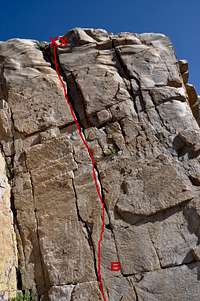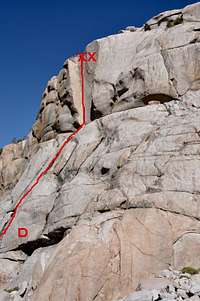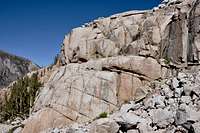-
 5980 Hits
5980 Hits
-
 87.76% Score
87.76% Score
-
 25 Votes
25 Votes
|
|
Mountain/Rock |
|---|---|
|
|
37.93670°N / 119.2282°W |
|
|
Trad Climbing, Sport Climbing, Toprope |
|
|
Spring, Summer, Fall |
|
|
9600 ft / 2926 m |
|
|
Overview

Ellery Crags are two neigboring rock formations near Yosemite National Park’s Tuolumne Meadows in the Sierra Nevada Range.
Although these two formations are very close together, only one of them has received the lion’s share of attention. This page will be dedicated, for the most part, to the more popular one. I am, however, including one paragraph on the secondary formation at the end of the “Routes” chapter.
It is not clear who thought of exploring the the climbing posibility on Ellery Crag, and I’m not sure how I heard or read about it, but I climbed most of the routes over twenty years ago. Ellery Crag to this area is like Pixie Rock is to Joshua Tree National Park. It’s small and steep. None of the routes are much more than forty five feet in height. Ellery Crag, however, posesses several crack systems and steep faces on its convoluted configuration.
The nearby Tuolumne Meadows, with it’s nine thousand foot elevation, has been a summer climbing Mecca for decades. There are, however, days that you just don’t want to deal with the run-outs Tuolumne Meadow climbs are famous for. That’s when you can get a good workout on Ellery Crag and not nesessarily risk life and limb in the process. The altitude of over nine thousand feet puts limitations on the seasons you can climb on any of the Tuolumne Climbs and Ellery Crag as well. The only access road from the east is Highway 120, and due to heavy snow fall it stays closed for a good part of the year. The access road from the west does not fare much better either as it stays closed six months out of the year.
Routes of Ellery Crags
The upper, or the more popular of the two formations, Ellery Crag sports several climbs that could keep you busy for at least one morning. This is a place where you can set up a top rope on any of the faces. On the left side, you have an overhang rated 10b. On the main face, there is a steep and beautiful crack rated 5.9. The crux of this crack is very close to the bottom. Once you are past the first twelve feet, you are jamming up a beautiful 5.8 crack to the top.
To the right of the face, you have an arete that is too inviting and intrguing not to try. Good luck with this arete as it turned out to be much too hard for me to get any where on it. And last, but not least, to the right of the arete you will find a great bolted face climb rated 10d. Funny thing is that this climb is called “Arete” but you don’t have to use the arete to climb it. You have plenty of face holds along the bolts untill the last ten feet, and even then you can find good holds further to the right. Climbing the pure arete would be much harder than 10d. This climb was bolted only in the past eight or nine years.
All the climbs on Ellery Crag have a double bolt anchor on top. However, some of the anchors are very close to the edge and may require a belay to set a top rope. Getting to the top is very easy and is done from the left side. There are, however, lots of loose rocks to negotiate. You also need to be watchful for many loose rocks above the formation. The base of Ellery Crag is covered by large and small boulders, but you will have no problem finding great belaying spots. Although the routes on this crag are leadable, most people prefer to top rope the climbs. Ellery Crag is at an elevation of 9600 feet and is northwest facing. Those factors make this little formation an ideal place to get a good workout on a warm morning.
In addition to the main Ellery Crag, there is another formation in the same vicinity. This satellite formation is actualy much larger than the more popular one, but it has been noticed only in the past few years. This lack of attention could be due to difficulty in approach and the fact that it’s not visible from the old road. This formation is about seventy feet high with the first two thirds low angle and slabby. The last twenty five feet is steep with a few crack systems. The most prominent crack is inside a beautiful dihedral and goes as 10a. There are at least two bolt anchors on top of this formation for rapelling or setting up top rope.
Climbs of Ellery Crags | |
| A | The Roof, 10b, anchor on top, there are more than one way to do the overhang |
| B | Gold Mine, 5.9, leadable, use a standard rack, good anchor on top, lookout for loose rocks, a hand crack and probably the best climb on this formation |
| C | Arete, 10d, four bolts, anchor on top, climb the face to the right of the arete |
| D | The Dihedral, 10a, a crack in a dihedral, located on the larger formation |
How to get there
The approach to Yosemite National Park from the east is done via Tioga Pass on Highway 120. About two miles before reaching the entrance to the park you pass by Ellery Lake. This Crag is located along an old bandoned jeep road across from the lake. Park your car close to the east end of the lake and walk across the dam. On the other side you will find this old dirt road that you follow for a few hundred yards. The main formation is obvious and to your right.The best way I found to the top or base of the lower formation, not visible from the road, is to drop down into the thick bush covered hillside very close to the main formation. Soon after, you can walk on low angle slabs and some scree to the second formation.
Camping
There are many campgrounds in the Tuolumne Meadows and Tioga Pass area. During the peak season, however, it’s possible that you end up driving from campground to campground looking for a campsite to no avail. It’s important to remember that you can always camp close to this area without being in the heart of it. There are a number of campgrounds along Highway 120, Tioga Pass Road, that can be used. There are also a number of camgrounds along Highway 395 and in the Mammoth Lakes area. It’s always a good idea to plan ahead and the following links should help a little.
Tuolumne Meadows Camping
Saddle Bag Campground
The Sierra Web/Camping
Mono Lake Station- 760-647-3000
Rush Creek, Mammoth Lakes Station- 760-924-5500












